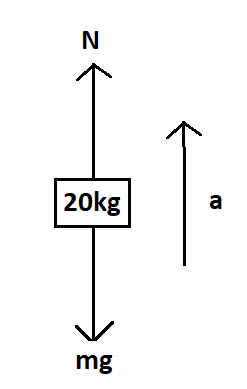Question #7c02d
3 Answers
(b)
Explanation:
We're asked to calculate the acceleration of the lift, given what a balance indicates the weight of a
I'll answer this without the use of a free-body diagram, and rather use more conceptual understanding... (it's always good to draw a free-body diagram when solving dynamics problems, though!).
The true weight
The spring balance, however, indicates its weight as
You may have felt a sensation in a lift/elevator before where you seem to weight more than you actually do. This happens when the lift/elevator's acceleration is upward, because while it's accelerating upward, you appear to push down on the elevator's floor with more force.
Therefore, the acceleration of the lift must be upward, since the
Since the acceleration is directed upward, the net force must also be directed upward, so the net force acting on the lift is
The acceleration is thus
Thus option (b) is correct.
b)
Explanation:
If the lift was not in movement
B
Explanation:
Before we start, we list out all the given information:
Reading on a weight scale is not to the normal/reaction force,
Newton's first law states that an object will remain its motion (stay at rest or continue moving at constant velocity if moving) there is no external force acting on it.
Newton's second law states that the motion of an object is directly proportional to the sum of motive forces.
Thus,
When the lift (elevator) is at stationary, the only force acting on it is Gravity. An object, in this case, a mass of
But now, the lift is accelerating.

[I assume the elevator is moving up]
[that's why i put positve a and it makes things easier]
[I use
[You may assume the elevator is moving down, you will reach the same answer eventually as negative signs would be cancelled off]
moving downwards with
Acceleration is vector quantity: with both magnitude and direction
Negative sign means downward, positive means upward
[Assuming the object is at origin on a cartesian plane. Moving up you will get positive value and vice versa.]

